This question originally appeared on Quora, the best answer to any question. Ask a question, get a great answer. Learn from experts and access insider knowledge. You can follow Quora on Twitter, Facebook, and Google Plus.
Answer by Paul Denlinger, have lived in China, Taiwan, and Hong Kong; fluent in Mandarin:
The most significant classical Chinese painting is the Qingming Shanghetu or Along the River During the Qingming Festival, which was painted nearly 900 years ago during the Northern Song dynasty.
This painting is significant for several reasons. First, up until this time, almost all Chinese paintings were landscapes, which did not feature people at all or had only a few people. Second, this is the first scroll painting to depict both Chinese and urban life during the period in the Northern Song dynasty’s imperial capital of Bianjing (now Kaifeng in Henan province). Third, the painting is highly detailed, featuring shops of all kinds, and we are able to see the Chinese technologies of the time, which help us a great deal in understanding how Chinese lived.
The original painting (there are more than one) was believed to have been an imperial commission of the Emperor Shenzong of Song or Emperor Huizong of Song, who ruled in the period from 1067 to 1125, and most Chinese art historians believe that it was painted by one person, Zhang Zeduan.

Courtesy of Wikimedia Commons
Art historians speculate that the reason an emperor wanted such a painting was because he wanted to show the prosperity of society in China at the time. The painting conveys an almost pastoral view of Chinese urban life, which is why it has been a theme copied by succeeding Chinese dynasties. The greatest irony of it all is that during the Northern Song dynasty, the northern territories of China were under attack by northern nomads, specifically the Jurchens. Eventually Bianjing fell to the Jurchens in 1127, and the imperial family was held hostage by the Jurchens. The Song dynasty lost its northern territories and the Southern Song dynasty with its capital at Linan (today’s Hangzhou) began.
The Northern Song dynasty was an interesting period. Although it was under threat of attack and invasion, the Chinese emperors of the period were more interested in cultivating the arts and culture than in military affairs and defense. The Song dynasty is well-known and revered for its paintings and china, which are collected by Chinese art connoisseurs all over the world. At a time when they should have been paying attention to defense, most of the later Northern Song dynasty emperors were more interested in calligraphy, poetry, the arts, and in building their own personal imperial art collections.
This was the period context of this painting when it was made. Over time, the painting has gained a larger following and has even been the subject of reverence by succeeding Chinese dynasties, even up until the People’s Republic.
One copy was believed to have been made during the Mongol Yuan dynasty, and the most significant copy was made during the Qing dynasty (1644–1912). This copy was updated, since it was painted approximately 500 years after the original. The paints, dress, and number of people in the painting were all updated and increased, and this copy was presented to the Qianlong emperor in 1737 at the beginning of his 60-year reign.
The original Song painting was a favorite of China’s last emperor, Puyi, who was forced to abdicate in 1912. He kept the painting with him when he was made the emperor of the Japanese puppet state of Manchukuo, and he surrendered it to the state in 1945 at the end of World War II.
The original Song painting is kept in the Beijing Palace Museum and has been taken for overseas exhibits several times. The Qing version was taken to Taiwan by the retreating Nationalist forces and is the property of the National Palace Museum in Taipei. Art curators and historians would love to see the Song and Qing versions exhibited together, but so far, Beijing and Taipei have not been able to come to agreement on how such an exhibit would be managed.
Historically, the paintings show how fragile Chinese prosperity has been. The Northern Song was one of the happiest and most cultured dynasties in Chinese history but was first overrun by the Jurchen and then eliminated by the Mongols. Within one generation of the end of the Qing emperor Qianlong’s reign, China would be defeated and humiliated by the British in the First Opium War (1840–1841). In a way, this is a reminder to Chinese rulers of how swiftly the tides of change can turn against them, even when the society looks prosperous on the surface.
More questions on Quora:
